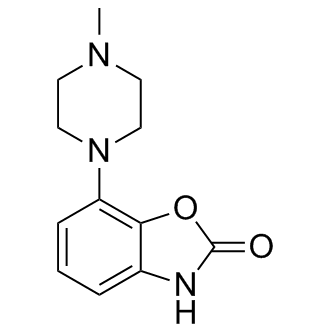| Description: |
Pardoprunox(SLV-308) is a novel partial dopamine D2 and D3 receptor agonist and serotonin 5-HT1A receptor agonist; D2 (pKi = 8.1) and D3 receptor (pKi = 8.6) partial agonist (IA = 50% and 67%, respectively) and 5-HT1A receptor (pKi = 8.5) full agonist (IA = 100%); also binds to D4 (pKi = 7.8), α1-adrenergic (pKi = 7.8), α2-adrenergic (pKi = 7.4), and 5-HT7 receptors (pKi = 7.2) with lower affinity. |
| In Vivo: |
Unified PD Rating Scale (UPDRS)-Motor score was improved in pardoprunox-treated patients (overall mean dose 23.8 mg/d; -7.3 points), as compared with placebo (-3.0 points; P = 0.0001), from baseline to end point. At end point, there were more responders (> or = 30% reduction in UPDRS-Motor score) in the pardoprunox group (50.7%) than in the placebo group (15.7%; P < 0.0001) [2]. Surprisingly in the SNc, pardoprunox (10 μg kg?1, i.v.) either partially or fully suppressed the firing activity in two separate populations of DA neurons. Finally, in the DRN, pardoprunox (5-40 μg kg-1, i.v.) completely suppressed the firing activity of 5-HT neurons. Moreover, the selective 5-HT(1A) receptor antagonist WAY-100,635 prevented and reversed the effects of pardoprunox [3]. |
| In Vitro: |
SLV308 acted as a potent but partial D(2) receptor agonist (pEC(50) = 8.0 and pA(2) = 8.4) with an efficacy of 50% on forskolin stimulated cAMP accumulation. At human recombinant dopamine D(3) receptors, SLV308 acted as a partial agonist in the induction of [(35)S]GTPgammaS binding (intrinsic activity of 67%; pEC(50) = 9.2) and antagonized the dopamine induction of [(35)S]GTPgammaS binding (pA(2) = 9.0). SLV308 acted as a full 5-HT(1) (A) receptor agonist on forskolin induced cAMP accumulation at cloned human 5-HT(1) (A) receptors but with low potency (pEC(50) = 6.3) [1]. |






















